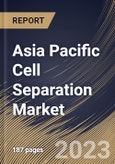Cell separation or isolation procedures are frequently used to create and manufacture biological materials, including recombinant proteins and monoclonal antibodies. In the past few decades, these products have significantly gained popularity. The demand for biologics has grown significantly along with the development of specialized medications and personalized medicine.
Cell separation is crucial for many different applications, including the design & development of biologics, the production of therapeutic proteins, in-vitro diagnostics, and other research applications like the collection of circulating tumor cells in the blood, molecular analysis of particular cell populations, isolation of immune cells from peripheral blood, preparation of a sample of blood separated from plasma, the separation of bacteria from food, and the investigation of the effects of drug candidates on cell types.
Millions of individuals continue to be affected by the HIV epidemic, and as of the end of 2018, an estimated 1.25 million HIV-positive people were living in China. HIV infection can be avoided, treated, and controlled but not cured. In China, the number of new HIV infections among young people is rising, especially among the crucial demographic. According to data released by the China Center for Disease Control, over 400 persons per day were given an HIV-positive diagnosis in 2018. This rising prevalence of HIV in the region has resulted in growth prospects for regional market.
The China market dominated the Asia Pacific Cell Separation Market by Country in 2022 and would continue to be a dominant market till 2030; thereby, achieving a market value of $1,433.8 million by 2030. The Japan market is registering a CAGR of 10.3% during (2023-2030). Additionally, The India market would showcase a CAGR of 11.6% during (2023-2030).
Based on Product Type, the market is segmented into Consumables (Reagents, Kits, Media, & Sera, Disposables, and Beads), and Instruments (Centrifuges, Flow Cytometers, Filtration Systems, and Magnetic-activated Cell Separator Systems). Based on End-Use, the market is segmented into Biotechnology & Biopharmaceutical Companies, Research Laboratories & Institutes, Hospitals & Diagnostic Laboratories, and Cell Banks. Based on Cells Type, the market is segmented into Animal Cell, and Human Cell. Based on Technique, the market is segmented into Centrifugation, Surface Marker, and Filtration. Based on Application, the market is segmented into Biomolecule Isolation, Cancer Research, Stem Cell Research, Tissue Regeneration, In Vitro Diagnostics, and Therapeutics. Based on countries, the market is segmented into China, Japan, India, South Korea, Singapore, Malaysia, and Rest of Asia Pacific.
The market research report covers the analysis of key stake holders of the market. Key companies profiled in the report include Thermo Fisher Scientific, Inc., Becton, Dickinson and Company, Merck KGaA, Danaher Corporation, Agilent Technologies, Inc., Bio-Rad Laboratories, Inc., Corning Incorporated, Terumo Corporation, STEMCELL Technologies, Inc. and Akadeum Life Sciences, Inc.
Scope of the Study
By Product Type
- Consumables
- Reagents, Kits, Media, & Sera
- Disposables
- Beads
- Instruments
- Centrifuges
- Flow Cytometers
- Filtration Systems
- Magnetic-activated Cell Separator Systems
By End-Use
- Biotechnology & Biopharmaceutical Companies
- Research Laboratories & Institutes
- Hospitals & Diagnostic Laboratories
- Cell Banks
By Cells Type
- Animal Cell
- Human Cell
By Technique
- Centrifugation
- Surface Marker
- Filtration
By Application
- Biomolecule Isolation
- Cancer Research
- Stem Cell Research
- Tissue Regeneration
- In Vitro Diagnostics
- Therapeutics
By Country
- China
- Japan
- India
- South Korea
- Singapore
- Malaysia
- Rest of Asia Pacific
Key Market Players
List of Companies Profiled in the Report:
- Thermo Fisher Scientific, Inc.
- Becton, Dickinson and Company
- Merck KGaA
- Danaher Corporation
- Agilent Technologies, Inc.
- Bio-Rad Laboratories, Inc.
- Corning Incorporated
- Terumo Corporation
- STEMCELL Technologies, Inc.
- Akadeum Life Sciences, Inc.
Unique Offerings
- Exhaustive coverage
- The highest number of Market tables and figures
- Subscription-based model available
- Guaranteed best price
- Assured post sales research support with 10% customization free
Table of Contents
Companies Mentioned
- Thermo Fisher Scientific, Inc.
- Becton, Dickinson and Company
- Merck KGaA
- Danaher Corporation
- Agilent Technologies, Inc.
- Bio-Rad Laboratories, Inc.
- Corning Incorporated
- Terumo Corporation
- STEMCELL Technologies, Inc.
- Akadeum Life Sciences, Inc.
Methodology

LOADING...








